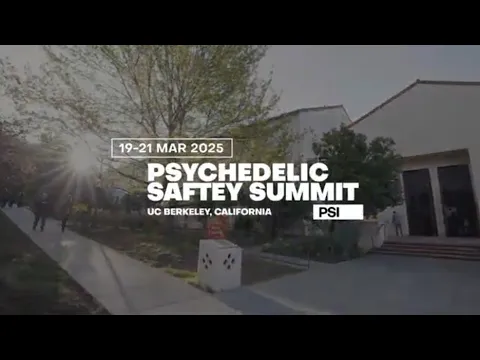
4.3
Overall rating
94%
Strategic ties
92%
Would return
44%
Tangible outcomes
90%
Work benefits
With expanding access and public interest in psychedelics comes greater need to create coordinated safety infrastructure in the psychedelic field. In March 2025, PSI hosted the Psychedelic Safety Summit with the support from the Educational Foundation of America and the William G. Nash Foundation. Advisory support was provided by the UC Berkeley Center for the Science of Psychedelics. This event brought together 140 participants representing a spectrum of the psychedelic ecosystem - from researchers and clinicians to policymakers, Indigenous knowledge holders, and community advocates - to work together to produce solutions to the most pressing challenges in psychedelic public health and safety. See the Summit website here.
Feels historic.

Robin Carhart-Harris
Distinguished Professor in the
Department of Neurology, UCSF
It's a whole new generation, you know, coming into their own who are now picking up the torch and moving forward… I'm impressed with the seriousness of the people here.

Charles Grob
Professor of Psychiatry and Pediatrics,
Harbor –UCLA Medical Center
I think that this gathering is one for the history books in psychedelic history… There's just been a lot of impeccable preparation for this gathering. And everybody feels that.

Kylea Taylor
CEO, SoulCollage, inc and Author
Summit Design
PSI conducted over 160 asynchronous virtual stakeholder interviews of subject matter experts on psychedelic public health and safety to identify the most critical safety challenges. This groundwork ensured the Summit focused on real-world priorities that matter most to communities, practitioners, researchers, policymakers, advocates, and community members.
Five Focus Areas
Participants worked within thematic streams representing different aspects of psychedelic safety:
Public Education & Perception - Creating clear, reliable, and culturally-aware information to help people make informed decisions about psychedelics.
Policy Development - Developing supportive policies and regulations that prioritize public health and safety at all levels of government.
Research - Generating evidence-based insights to support effective psychedelic safety and harm reduction approaches.
Safety Net - Ensuring people have appropriate support before, during, and after psychedelic experiences—especially when challenges arise.
Training & Service Provision - Establishing consistent standards and practices for practitioners across clinical, ceremonial, and community contexts.
How We Worked Together
The Summit used a collaborative workshop format where participants rolled up their sleeves to solve problems together. Rather than sitting through presentations, attendees self-selected into cross-disciplinary project teams tackling specific challenges they cared about most. The emphasis was on doing, not just discussing — creating real outcomes that advance psychedelic safety. See Summit attendees here.
Achievements and Progress
The Summit was a catalyst, not a solution. The real work happened when participants collaborated. Here's what they accomplished together:
Research & Academic Collaboration
Multiple research initiatives launched at the Summit, establishing the scientific foundation for evidence-based safety practices. Teams created a shared repository of harm reduction measures across academic institutions and developed studies on safety frameworks and adverse event definitions. New methods for substance testing standards and access emerged, along with alternate drug checking models designed for differing regulatory environments.
Coalition Building and Infrastructure for Safety
Participants built foundational resources and partnerships to support the field's growth. Cross-organization partnerships formed to align on curriculum standards and care frameworks. A funding proposal was submitted for a safety-informed marketing center to support responsible industry growth. A publicly accessible repository for safety protocols, ethics, and best practices was established, creating living documents that can evolve with the field. Perhaps most significantly, organizations doing complementary work—who had long respected each other but never connected—finally met, identified areas of collaboration, and formed partnerships.
Public Education & Safety Programs
New initiatives developed to support safer psychedelic use across all contexts. Public education campaigns began taking shape to improve community awareness. Teams designed expanded crisis response training programs for law enforcement and broader audiences. Practitioners gained access to new screening resources that help distinguish between spiritual emergencies and psychiatric crises, enabling more appropriate responses when challenges arise.
Policy & Regulatory Progress
The Summit catalyzed coordination on policy and regulation. Psychedelic organizations aligned their policy efforts and engaged actively in advising state regulatory advocacy and implementation. New coalitions formed to coordinate guidance and best practices for federal agencies, creating pathways for more informed decision-making at the highest levels of government.
Summit Impact by the Numbers
Participants gave a 4.3/5 overall rating of the experience
92% said they would attend again
94% formed new alignments or collaborations
90% said the summit benefited their existing work
44% reported tangible outcomes within weeks of the summit
This is Just the Beginning
The Summit planted seeds for long-term transformation on this topic. By bringing together science, policy, clinical expertise, and lived experience, it established a constellation of individuals and organizations committed to psychedelic safety. As one participant observed, it “broke the seal on only having a few squeaky wheels talk about safety and made it something we should all care about."
The work continues, helping the psychedelic ecosystem prioritize psychedelic safety. Please stay tuned!
Table of contents





